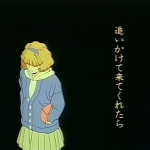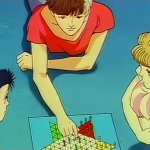A For A-Girl
I happened to come across and watch Madhouse’s 30 minute A-Girl OVA originally released on September 24, 1993. Despite being an early 90’s release, this production is firmly rooted in the whimsical and creative expressionist style of the 1980s. The adaptation of Fusako Kuramochi’s two volume shoujo romance manga from 1984 is most immediately unique because it contains no spoken dialogue. Similar to the later and slightly better known Omishi Magical Theater Risky Safety episode 16, the entire A-Girl OVA takes the form of a silent movie with sound effects, background music and several nice vocal pop songs, and the minimal necessary dialogue presented as text on screen.
Kitaro Kousaka, whose resumé includes directing Madhouse’s two Nasu movies and the Clover short film, serving as animation director for Ghibli’s Whisper of the Heart, Spirited Away, and Howl’s Moving Castle, and providing key animation for landmark anime including Angel’s Egg, Twilight Q Part 2, Akira, Laputa, Nausicaa, and Metropolis, made his directorial debut with this OVA. Kousaka also provided the OVA’s animation character designs. His confident and skillful supervision results in an anime that exhibits consistently interesting cinematography and an excellent sense of movement and timing that has enough restraint to be effective without ever being distracting. The visual aesthetic is characterized by a soft, almost watercolor design similar to the earlier Machikado no Meruhen OAV and the later Honey & Clover TV series. The character and clothing design, editing, and adult shoujo drama evoke the TO-Y, Nineteen, and Shiratori Reiko de Gozaimasu OVAs.
The story about Mariko, a young woman who encounters surprises and heartbreak as her life intersects and diverges with the young man destined to eventually become her soulmate is and isn’t difficult to follow in untranslated Japanese. The OVA unfolds as a series of vignettes taking place over a span of several years, so the jumps in time are initially a bit jarring, and suddenly seeing the characters appear older comes as a momentary shock. But the animation concentrates on pivitol moments, allowing it to literally paint its central points and tell its story primarily through animation and tone rather than spoken dialogue. Viewers used to slightly more conventional, contemporary anime may find A-Girl difficult to swallow because it requires a bit more patience and investment than an ordinary anime, even despite its short length. While this may not be one of anime’s greatest lost treasures, it certainly is obscure and it is quite good. It’s gratifying as a rare serving of adult romance that entirely avoids exploitation and sappy melodrama. It’s also a fascinating throwback example of anime that’s more interested in being creative and interesting than being commercial or easily marketable. The A-Girl OVA is one of the few anime productions that exists as an example of anime that aspires to be artistic and praiseworthy without being pretentious. I’m glad that this OVA hasn’t been completely forgotten but a little disappointed that it’s not currently in commercial circulation.




















